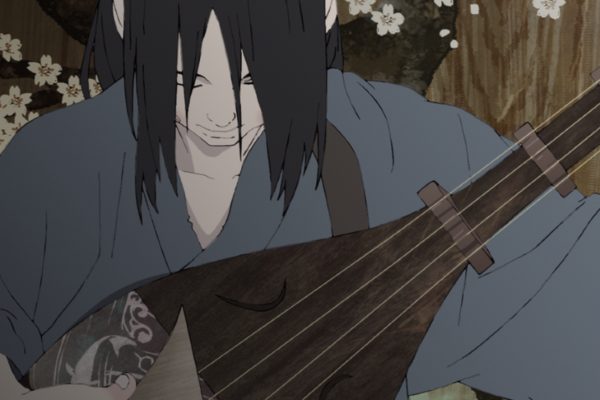Adapted from a successful novel, Inu-oh is a historical tale of the emergence of the Noh style of theatre during a politically unstable time – 14th Century Japan – and incorporates elements of fable and the supernatural. Its protagonists are the titular Inu-oh and Tomona, a duo whose passion for storytelling and art – along with their status as social outcasts – draws them together. Inu-oh, based on a legendary character, is a disfigured pariah perpetually masked and covered in baggy clothes. Tomona – a man who was blinded as a child by a cursed sword which also killed his father – befriends him, and the pair become singing, dancing celebrities, celebrated for their outlandish performances that portray ancient myths.
Structurally, the film is unorthodox and a little tricky to get a handle on. It begins with fast-paced exposition, providing us with each of the central characters’ origins, as well as a look into the film’s historical context – that of the annihilated Heiki clan. The pace then slows as the characters meet and bond, and the final hour almost exclusively comprises lengthy musical montages of Inu-oh and Tomona’s performances around the country.
The colour palette is used cleverly. When portraying the angst of the troubled society, the hues are mainly earthy and placid, almost recreating faded illustrations from historical tomes or tapestries. However, brighter tones and vivid colours are introduced along with a more visceral sense of speed to accompany the central duo’s performances and influence over their audiences. Towards the end, we even veer into psychedelia. A standout element is the beautiful animations conveying Tomona’s perception of the world in smoky streaks and soft watercolour smudges. Similarly, some of the dance segments use light and 3D motion to recreate a mesmerising sense of movement and life.
The film is a triumphant story of adversity and creativity. Its varied animation styles and use of colour and light are, at times, hypnotic. However, it can also be tough to penetrate in places, particularly early on, and some of the musical segments do linger just a little too long. It’s a demanding film that requires focus but also provides visual rewards – mainly in its final act – and an intriguing sense of magic.
Screening as part of Glasgow Film Festival 2022
